Balinese cats, with their sleek bodies and enchanting blue almond-shaped eyes, have captured the hearts of cat enthusiasts worldwide. Renowned for their graceful demeanor and striking appearance, these feline companions often leave their owners curious about their unique behaviors, including the age-old question: Do Balinese cats purr? In this article, we will delve into the fascinating world of Balinese cats and explore the nuances of their purring habits.
The Balinese Cat: A Brief Overview
Before diving into the mysterious realm of purring, it’s crucial to understand the fundamental characteristics of Balinese cats. Originating from the Siamese breed, Balinese cats boast a striking resemblance to their Siamese counterparts but possess a distinctively longer coat. Their silky fur and elegant posture make them stand out among other feline breeds, and their sociable nature often endears them to families seeking a loving and interactive pet.
The Science Behind Purring
Purring is a universal language among domestic cats, often associated with contentment, relaxation, and communication. But do Balinese cats share the same inclination to purr as their fellow feline companions? To comprehend this, we must first explore the science behind purring. Domestic cats, including Balinese cats, produce a purring sound by rapidly contracting and relaxing the muscles within their larynx (voice box). This involuntary action results in the rhythmic vibration of the vocal cords, creating the familiar and soothing purring sound.
Balinese Cats and Their Purring Patterns
Now that we’ve unraveled the science behind purring, let’s focus on Balinese cats specifically. Much like their Siamese relatives, Balinese cats are known for their vocal nature. While some feline breeds may be more reserved in expressing themselves through purring, Balinese cats tend to be quite communicative. They often use purring as a means of establishing a connection with their owners, expressing contentment, and seeking attention.
Purring as a Form of Communication
For Balinese cats, purring goes beyond a simple expression of pleasure. It serves as a sophisticated form of communication, allowing them to convey a range of emotions and needs. When a Balinese cat purrs, it can signify not only happiness but also a sense of security, comfort, or even a request for companionship. Understanding these subtle cues is essential for cat owners to strengthen their bond with their Balinese companions.
The Influence of Environment on Purring
Balinese cats, like many other feline breeds, are highly attuned to their surroundings. The environment plays a significant role in influencing their purring behavior. A calm and familiar setting often encourages Balinese cats to express contentment through purring, while stressful or unfamiliar situations may lead to a decrease in purring. Observing and understanding the impact of the environment on a Balinese cat’s purring patterns can provide valuable insights into their overall well-being.
Balinese Cats and Human Interaction
One of the endearing qualities of Balinese cats is their love for human interaction. These social felines thrive on companionship and often form strong bonds with their owners. When engaged in positive interactions with their human companions, Balinese cats are more likely to purr as a sign of happiness and satisfaction. Regular playtime, gentle strokes, and a comfortable lap can elicit a symphony of purring from these affectionate felines.
Health Indicators: Purring in Balinese Cats
While purring is generally associated with contentment, it can also serve as a subtle indicator of a Balinese cat’s health. Changes in purring patterns, such as excessive purring or a sudden absence of purring, may warrant attention. Cats, including Balinese breeds, may purr more when they are unwell or in pain, using it as a self-soothing mechanism. Responsible cat owners should monitor their Balinese cats’ purring behaviors as part of overall health awareness.
Balinese Kittens and Purring
The enchanting world of Balinese cats begins with their adorable kittens, and understanding purring in the early stages of life is essential. Balinese kittens start purring shortly after birth, often as a way to communicate with their mother and siblings. As they grow and develop, purring remains a fundamental aspect of their communication, helping them establish bonds within their feline family and, later, with their human caregivers.
Purring Variations among Balinese Cats
Just as every individual has a unique personality, Balinese cats may exhibit variations in their purring habits. Some Balinese cats may be more vocal, expressing themselves frequently through purring, while others may be more reserved in their vocalizations. Factors such as genetics, upbringing, and individual temperament contribute to these variations. Understanding and appreciating these differences can enhance the relationship between Balinese cats and their owners.
Conclusion: The Harmonious Symphony of Balinese Cat Purring
In conclusion, the question of whether Balinese cats purr is not only answered but explored in depth. These elegant felines, with their captivating blue eyes and silky fur, are not only adept at purring but use it as a powerful tool for communication, connection, and expression. As a responsible owner of a Balinese cat, recognizing the significance of purring and its variations is key to fostering a strong and harmonious bond with these enchanting companions. So, the next time your Balinese cat graces you with a purr, relish in the symphony of contentment and companionship that defines the unique world of Balinese cats.
Related Topics:
Do balinese cats need a lot of attention
What are balinese cats known for
Are balinese cats talkative

























